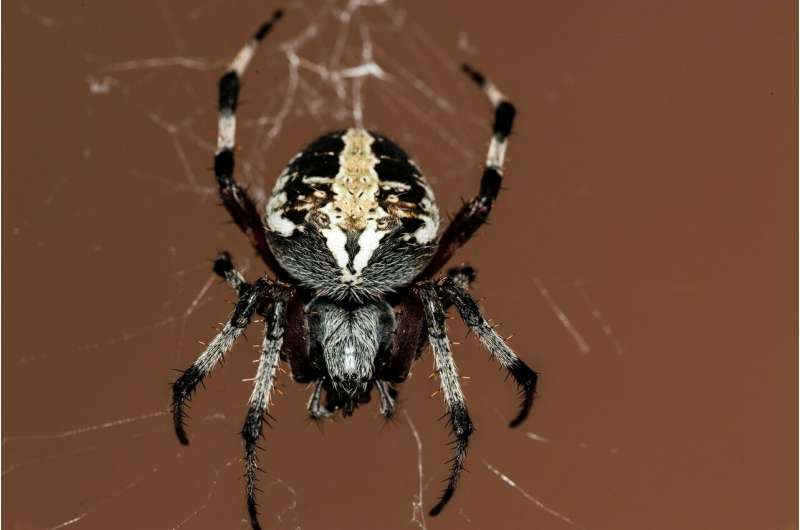Spiders really may be more scared of you than you are of them

Spiders have evolved creative strategies to allow them to thrive in habitats across the globe. The one thing that seems to elude them though, is the ability to charm the humans that they encounter.
But what about the spider's perspective of humans when they find a new home near us? It's not possible to read a spider's mind, but research has uncovered some surprising insights about how they behave around humans.
Take the Jorō spider, Trichonephila clavata. News reports have about the palm-size Jorō spider recently settling in parts of the US.
This spider is native to part of eastern Asia but over the last decade has established itself in the US, following its cousin, the golden silk spider Trichonephila clavipes, which arrived .
But its behavior suggests it may be more worried about us than the other way around. The Jorō spider has a tendency to play dead. This ploy is known as among scientists. It is a response to threats used by many creatures in the animal world, including other arachnids such as scorpions.
Playing dead
It's common for spiders to do this in response to a potential hazard, or even as part of their mating strategy. What is unusual about the Jorō spider though, is just how long it keeps up the act. A of ten spider species found most spiders froze for about a minute in response to a few rapid puffs of air. Jorō spiders lay motionless for more than an hour.
Playing dead at specific times is an . It reduces the chances of being eaten by predators or potential mates, such as cannibalistic Pisaura mirabilis (European nursery web spider) females.
It might come with a cost such as missing out on a passing feast in the form of a flying insect. But playing dead is probably a more energy efficient way of staying safe from a predator than active defensive strategies. For example, Pholcus cellar spiders will spend far more energy trying to confuse and deter predators by whirling around in their webs.
Aggressive responses spiders use include raising their legs and moving their fangs to scare off other animals. More often though, responses to perceived threats—including an approaching human—. Examples include hiding or camouflaging against a background, masquerading as a different species, or even hiding behind other predators. The latter is adopted by that take refuge from spiting spiders by hiding in ant nests.
But the Jorō spider has a conspicuously colored, gold and black body, and builds large webs one meter in diameter. It's too large to hide and too distinctive to masquerade or mimic so must rely on other strategies, including playing dead.
Who is scared of who
It's not clear why we are so susceptible to arachnophobia, but studies show humans have similar emotive reactions to very different animals (wolves, crows, spiders). Scientists suggest these fear responses to other animals are driven by a need to control our .
fuel people's assumptions that spiders have bad intentions towards us. And these sentiments are reinforced by the of big spiders in our gardens and under the sofa.
Some spiders, such as the recluse spiders of the US, have a bite that but even then, the threat they pose is . To put it in context, no spider appears on the WHO's but domestic dogs and cats do.
Tens of millions of people are reportedly injured by domestic dogs each year. Stories about the benefits of spider venom, for example as templates for that may one day be used to treat pain and diseases such as cancer, get a lot less media attention than spider bites.
People are also almost certainly more dangerous to spiders than the other way around. This is because our food production systems rely on insecticides that are lethal to spiders and are probably contributing to . This is a problem for humans because spiders have an important role in agriculture, eating pest insects. Their decline might have long-term consequences for what you put on your table.
As a biologist, I can't help but feel impressed by the imaginative solutions spiders use to cope with the world around them. They construct —from giant orb webs complete with decorations (called stabilimenta), to cunningly disguised trapdoors in the ground.
Spider silk allows them to live everywhere from the , to the of ponds, to .
When small, spiderlings can travel thousands of kilometers by wind, using silken sails. In the same way that our life experiences shape us, the spider's journey also shapes its future. This is because the environments young spiders experience during development, such as temperature or the amount of food available, can influence later life strategies, or deciding whether to stay somewhere or move away.
The Jorō is also capable of flying in the air as a spiderling, but its recent arrival in the US is probably the result of human activity. For example, hitching a ride in your luggage or on commercially transported goods. And our concern about their spread is best focused not on the spider itself, but on potential ecosystem disruption lower down the food chain.
New arrivals to an area—including this spider—might compete with resident species for food, or influence other types of plant or animal in unexpected ways. In Florida, for example, invasive Cyrtophora spiders sometimes spin so much silk that they cause problems for host plants, potentially .
This example serves as a reminder that the consequence of a spider's actions might be more complicated than it first appears—passive or not. We benefit from improving our understanding of spiders. This will be easier if we can stop viewing them through an emotive lens.
Provided by The Conversation
This article is republished from under a Creative Commons license. Read the .![]()




















